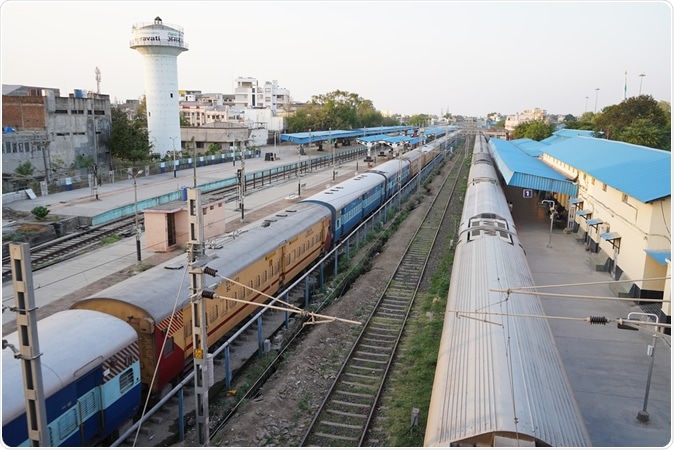Many studies have been published, starting from the early days of the COVID-19 pandemic, based on a number of modeling techniques. Some of the more popular are the Singapore models and the CDDEP models, which have been applied to many countries, including India.

New Delhi, India - March 30th, 2020: Deserted Connaught Place at the time of lockdown due to quarantine for Covid 19, one of the largest business, commercial and financial centres in New Delhi, India. Image Credit: Prabhsas Roy / Shutterstock

 *Important notice: medRxiv publishes preliminary scientific reports that are not peer-reviewed and, therefore, should not be regarded as conclusive, guide clinical practice/health-related behavior, or treated as established information.
*Important notice: medRxiv publishes preliminary scientific reports that are not peer-reviewed and, therefore, should not be regarded as conclusive, guide clinical practice/health-related behavior, or treated as established information.
Early Predictions About India
An early Indian study pegged the final number of cases at 13,000 and predicted that India would enter a state of equilibrium by the last week of May 2020. This projection was based on a combination of three models, an exponential/ logistic/SIR (susceptible-infected-recovered) model.
Another researcher reviewed the results of four studies based on an adaptation of the SIR model. Namely, the Susceptible, Infected, Exposed, and Recovered (SIER) model. These projections varied from suggesting that at the peak, India would remain at the least 100 cases /10,000 population, for a total of 1.35 infections, to a Cambridge study which predicted a decline in cases immediately following a 21-day lockdown. The reviewer rightly discounted all the conclusions as unbelievable, the more so since they were based on a paucity of data.
Another more recent study based on the situation in India specifically put forward an estimated basic reproduction number (R0) of 2.66 in the absence of any intervention, 2.00 if under moderate lockdown, and 1.5 under a complete lockdown. Another researcher predicted a mean of 211 deaths per week by week 5 and 467 per week by week 6 of the epidemic. Neither predicted the number of cases.
The inevitable conclusion drawn from these attempts to project the course of the pandemic in India is the difficulty of estimating with a reasonable chance of success. The current study, nonetheless, turns to the task with more confidence, based solely on the availability of more data.

AMRAVATI, MH, INDIA 22 MARCH 2020: Parked trains at Amravati railway station during curfew imposed as a preventive measure against the COVID-19, Appeal of Prime Minister Indi. Image Credit: CRS PHOTO / Shutterstock
How Was the Current Model Constructed?
With more than 50 successive days having passed since India registered the first 100 cases, it is possible, according to the researchers, to make “more plausible predictions” regarding the number of cases, the recoveries, the deaths, and the case fatality as the ratio of deaths to recovered patients at any stage. This was preferred to the more usual calculation of deaths to infected patients, since many patients are still hospitalized at any stage of analysis in the current scenario, and the outcome is unknown.
The researchers collected the data about each of these events from the website COVID19India.org starting from March 14, 2020, when India recorded the first 100 cases. From then on, they calculated the number of new cases, new deaths, and new recoveries each day until May 5, 2020, as well as the case fatality.
The Empirical vs. Theoretical Models
They then built what they term the Empirical Model, in which they analyze the rate of acceleration or slowdown in terms of the increase in new cases, in new recoveries, and new deaths. They avoided mathematical modeling, using only the observed trend in percentages.
These calculations were extended first to the end of May, when they were found to yield a somewhat correct picture of the course of the epidemic from April 20 to May 5, 2020. This led them to extend them further to the end of June as well.
Multiple epidemics have been modeled in the past, such as SARS, MERS, and HIV, which all are skewed to the right because of the sharp rise and slow fall. Based on the depiction of a similar trend in the current epidemic as well, the study also includes a Theoretical Model that uses a gamma function, since this shares the same property.
What Are the Current Projections?
The study found that on May 5, 2020, almost a third of patients had completed their disease course, having reached one of two outcomes – death or recovery. The death rate based on the total number of infections was 3.4%, but according to the death: recovery ratio, it is 8:1, for a case fatality of 11%.
On May 5, there were 127 deaths for 1,424 recoveries, giving a case fatality of almost 9%. In short, the researchers found a drastic decline in the fatality from almost 20% in the early phase to 10% in the week ending May 5, 2020.
Similarly, the initial rapid increase in the number of cases, which increased by 20% at one point, showed a steady decline by about 0.5% for several days towards the end of April. By May 5, 2020, the acceleration was only 6.4%.
The researchers attribute this to social distancing and lockdown and expect the decline to continue steadily until it reaches 0.1% when it may slow down a little due to the emergence of some new cases.
Projected Total Cases, Fatalities and Active Cases
The Empirical Model projection based on this shows that altogether, there may be 1,27,000 cases by the end of May, and 1,75,000 by the end of June. The peak number of new cases is likely to touch 3300 per day in the fourth week of May, following which it will begin to turn downwards. (However, at present the number of new cases in India has already crossed 3,900 per day in the second week of May, and is still rising).
Encouraged by this trend, the researchers say, “At this rate, most of the epidemic is likely to end by the fourth week of June.”
The total number of recoveries is also increasing by about 0.6% per day, having come up from 10.3% on April 10, 2020, to 29% on May 5. The last ten days of this period show the reverse trend with a decline of 0.5%.
The researchers expect that 41% of infected cases will recover by the end of May, and 56% by the end of June. In other words, almost 100,000 cases will recover by the end of June 2020.
The case fatality also shows a fall from about 25% in the early days of the epidemic to the current rate of 10% on May 5, remaining stable at this level.
The importance of being able to forecast the active caseload is obvious – these are the ones that may require treatment and thus place a demand on the healthcare system. The Empirical Model projects a peak in active cases at 75,000 in the second week of June 2020. Assuming that one in five will require hospital admission, and 10% will need invasive mechanical ventilation, this caseload will result in a hospital bed requirement of 15,000 (each bed to be occupied for about ten days), and about 7500 ventilators.
Empirical Superior to Theoretical Model
The Theoretical Model indicates that the peak will occur around the second week of May, at about 2500 new cases a day. (This has already proven to be too low an estimate, at the time of publication.) According to this model, the epidemic will nearly be over by the second week of July 2020.
Of the two, the scientists say that the Empirical Model appears to be more likely since
- it is constructed on the basis of the findings already observed.
- it is possible that viral transmission will be markedly less in May and June, because of the dry heat and exposure to ultraviolet rays in sunlight over a significant part of the country.
The researchers postulate that the high percentage of recovery without treatment may be due to the strong immunity built up by the people of India. This, in turn, is supposed to be due to the vegetarianism practiced by a large part of the population, or more likely the high prevalence of BCG vaccination. A second finding is that the case fatality is about 10% if only the cases with known outcomes are taken into account.
The researchers say, “This may eventually decline as our medical care system learns to manage these cases and new strategies such as convalescent plasma therapy and drugs such as Remedesivir succeed.”
The deliberate avoidance of mathematical modeling, as well as the choice not to use the basic reproduction number, are because of the preferred usage of a trend-based projection based on data collected for over 50 successive days. The researchers say the end of the epidemic in India may well be in sight with much less loss of life and less suffering than has occurred in many developed countries.
However, the current scenario in India is less encouraging, with the current doubling time being 12 days, crossing the projected peak number of cases per day two weeks earlier, and the graph showing no signs of flattening as yet.

 *Important notice: medRxiv publishes preliminary scientific reports that are not peer-reviewed and, therefore, should not be regarded as conclusive, guide clinical practice/health-related behavior, or treated as established information.
*Important notice: medRxiv publishes preliminary scientific reports that are not peer-reviewed and, therefore, should not be regarded as conclusive, guide clinical practice/health-related behavior, or treated as established information.